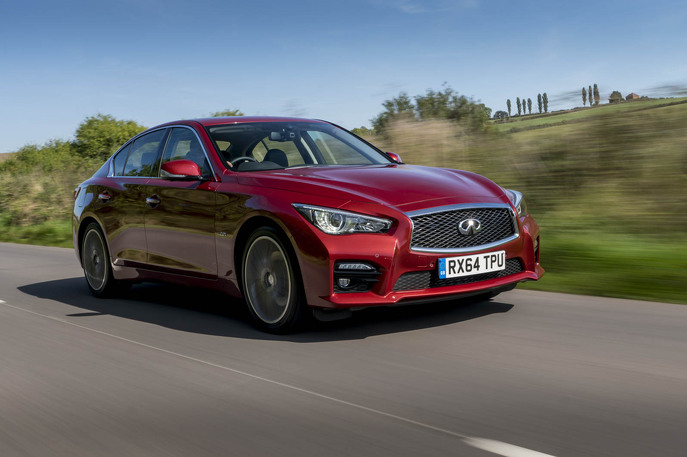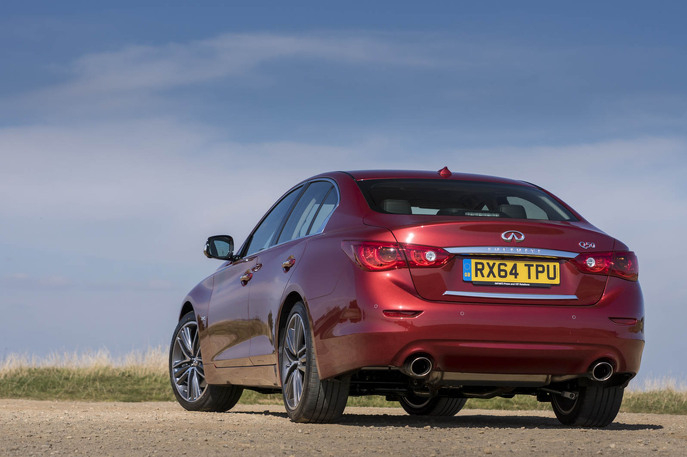2016 Infiniti Q50 sports saloon: new engines and chassis technologies deliver empowering performance

Next-generation Direct Adaptive Steering leads dynamic enhancements
All new powerful and efficient turbocharged V6 gasoline engines
Dynamic Digital Suspension offers a number of engaging ride options
Hong Kong - The new 2016 Infiniti Q50 sports saloon is being launched with a number of performance and dynamic upgrades that deliver a more empowering and rewarding drive experience. The comprehensive updates include next-generation ride and handling technologies and all-new advanced turbocharged V6 powertrains.
Making its debut on an Infiniti is the company's second-generation Direct Adaptive SteeringTM, comprehensively modified from the ground-breaking first-generation system. The standard steering mode now offers advanced levels of steering feel and feedback - more akin to that of a conventional steering system.

The new Q50 also features Infiniti's Dynamic Digital Suspension (DDS) for the first time, which gives the sports saloon an optimal blend of ride comfort and class-leading response and agility. For those drivers looking for a blend of dynamic settings tailored to their own particular requirements and tastes, the Q50's Drive Mode Selector (DMS) can be augmented with a ‘Personal' mode, which permits a bespoke mix of engine, suspension and steering characteristics.
Five powertrain options are offered with the Infiniti Q50, and for the 2016 model these include an advanced, all-new 3.0-litre V6 twin-turbo gasoline engine with direct injection. This new ‘VR30' engine in Europe is available in only one state of tune: 400 hp - (300 hp also available for Middle East); developed to provide an ideal mix of drivability, efficiency and performance.
The Q50 was developed from the outset to showcase Infiniti's daring design, dynamic performance and class-leading technologies within the sports saloon segment. Now in its third year, Q50 global sales between January and October 2015 reached almost 50,000 cars - representing a 65% increase compared to the same period in 2014.
"The new Infiniti Q50 takes the core elements that have driven its global appeal to date, and now we are offering a number of new and stand-out technologies. With the upgraded Q50, we are furthering Infiniti's position on innovation."
Francois Bancon, Infiniti Vice President Product Strategy

Dynamic performance from innovative technology
A range of new and innovative ride and handling technologies deliver on the promise of the Q50's daring design, and install confidence in all driving conditions.
Infiniti Q50 models equipped with the new 3.0-litre V6 twin-turbo engine, or the hybrid powertrain, come available with the second-generation Infiniti Direct Adaptive SteeringTM, which has undergone significant re-tuning to greatly enhance steering feel and feedback.
The changes to DAS - the world's first digital steering system - have been made following extensive consultation with existing Q50 customers around the world and over 625,000 miles of testing.
For the new second generation Direct Adaptive Steering, engineers have optimized the control logic to improve feedback from the road. They have fine-tuned parameters so that the default setting better mimics the feeling drivers are used to from conventional systems.
The new system also provides more customisation options, giving drivers' flexibility to choose the level of steering assistance and feedback according to personal preferences. In addition, Direct Adaptive Steering actively adjusts the steering ratio and effort according to vehicle speed and scene. In slow-moving situations, such as city driving or parking, the system is tuned for ease of manoeuvrability. In order to further enhance the steering feel in sporty driving conditions, the steering effort on the second generation Direct Adaptive Steering gradually saturates with high lateral G-force and acceleration in line with the overall vehicle behaviour.
Direct Adaptive Steering is able to transmit the driver's input to the wheels faster than a mechanical system while requiring fewer steering corrections and is able to make 1,000 steering adjustments per second. The new system enhances the steering feel by quickly and intelligently communicating to the driver feedback about road surface and chassis behaviour. This gives the driver a secure and confident feeling at the wheel, free from unnecessary steering kickbacks or vibrations.
The expanded selection of steering modes within Direct Adaptive Steering is accessed through the Drive Mode Selector (DMS). Located via menus displayed in the centre console, DMS allows the steering response to be selected from six available options: ‘Personal' ‘Standard', ‘Snow', ‘Eco', ‘Sport', and - new for the 2016 Q50 model - ‘Sport+'.
The Personal steering mode allows for a high degree of fine-tuning. Drivers first select one of three core ‘Modes' (Standard, Sport and Sport+) and then specify their preferred level of ‘Response' (Default, Dynamic and Dynamic+). For a slower steering response and conventional feel, the driver would select a combination of ‘Standard' mode and ‘Default' response. For the highest level of precision, the driver would choose ‘Sport+' mode with ‘Dynamic+' response - making best use of Direct Adaptive Steering technology.
The Sport mode of the Drive Mode Selector enhances the response of Direct Adaptive Steering elevating the steering effort required while reducing the required steering movement from lock to lock. In the new Sport+ mode, steering effort remains the same as Sport mode, but the response of the steering is further increased, with an even quicker gear ratio for an enhanced performance feel. With both the Sport and Sport+ modes the result is an even greater sense of connection and control when the car is being put through its paces.
The new version of Direct Adaptive Steering works with Active Lane Control to maintain lane positioning against crosswinds and uneven road surfaces. This semi-autonomous capability is a precursor to future steering systems that will form a key building block on the way to achieving fully-autonomous driving.
As standard, Q50 models equipped with the new 3.0-litre V6 twin-turbo engine feature Infiniti's RACK Electronic Power Steering. This all-new system provides a linear and in-control driving experience that can be tuned through the Drive Mode Selector.
When making a steering input or returning the steering wheel following an input, traditional steering system can create an unnatural feeling through imprecise control of the power assistance, reducing the feeling of linearity. To counter this, Infiniti's RACK Electronic Power Steering precisely increases the steering effort required as the vehicle's yaw rate changes, before adjusting to provide more assistance when the wheel returns towards on-centre.

2.0-litre petrol and 2.2-litre diesel models are equipped with a speed-sensitive hydraulic electronic rack-and-pinion power steering system as standard. This increases assistance at low speeds and reduces assistance for enhanced feel and response at higher speeds.
The Q50 features a multi-link suspension and, for the 2016 model, revised suspension settings provide an improved balance between confident handling and a comfortable ride. The front suspension is a double-wishbone design, while the revised rear suspension utilizes a multi-link design with coil springs and Dual Flow Path® shock absorbers. Extensive use of aluminium components for the suspension keeps weight down.
The Q50 now benefits from revised front and rear stabilizer bars. The result is heightening resistance to unwanted adjustments in the lateral movement of the suspension, affording a flatter ride and greater agility during cornering. The revised system is also better able to maintain contact between the tires and road.
2016 Q50 Sport models with 3.0 twin turbo powertrain are upgraded with Dynamic Digital Suspension (DDS) for the first time, which offers enhanced ride comfort with class-leading response and agility. The shift from a comfort-biased ride to enhanced dynamic response can be made when the driver places the electronically adjustable shock absorbers in either Sport or Sport+ modes (adjusted via the Drive Mode Selector), providing firmer damping control for more agile handling. While in these modes, the suspension is constantly adjusting to provide ideal performance and a flat ride.
In all modes, Dynamic Digital Suspension also constantly adjusts the shock absorber valve within a wide range of damping force to control body motion when cornering. It monitors body roll, pitch and bounce rate to restrain body motion for a comfortable, confident and insulated ride in all conditions, ensuring that bumps and undulating road conditions are absorbed to maintain flat body pressure.
Infiniti's most advanced V6 leads the refreshed engine line up
The all-new 3.0-litre V6 twin-turbo engine from the new and exclusive VR powertrain family has been developed to deliver optimal power and torque, alongside greater fuel efficiency. The high-output version of the power unit delivers 400 hp (298 kW) at 6,400 rpm and 475 Nm (350 lb-ft) maximum torque at 1,600-5,200 rpm; while the 300 hp (224 kW) version (at 6,400rpm) produces 400 Nm (295 lb-ft) torque at 1,600-5,200 rpm.
These outputs have been achieved while ensuring an improvement in fuel efficiency of up to 6.7%, representing a best-in-class power-to-efficiency ratio for the 400hp power unit.

This power-to-efficiency performance was made possible thanks to a combination of newly-developed powertrain features.
An advanced new twin-turbo system contributes to the smooth and immediate power delivery while promoting gains in efficiency. The combination of a new turbine speed sensor and an optimized turbine blade design realize greater performance with more immediate response. The turbine speed sensor allows a 10% increase in turbine speeds, enabling the turbocharger to revolve at up to 220,000 rpm. With greater capacity for faster revolutions, the twin turbochargers enable the engine to deliver greater power and torque.
Advanced valve timing control incorporating a new electric motor mounted to the valve timing system delivers quicker reactions to driver inputs. As well as improved response, more immediate valve timing also helps the engine operate more efficiently, precisely controlling fuel and air quantities entering the combustion chamber.
A new high pressure direct injection gasoline (DIG) system, introduced for the first time, allows for precise control of fuel injection into the combustion chamber depending on throttle position and current engine speed. DIG contributes significantly to making the new engine the cleanest and most efficient V6 that Infiniti has ever offered.
2.0-litre turbo, 2.2-litre diesel and hybrid powertrains blend performance and efficiency
Complementing the new 3.0-litre V6, Infiniti Q50 offers is a 2.0 litre four-cylinder turbocharged engine, delivering 208 hp with peak torque of 350 Nm, and a 2.2-litre diesel offering 168 hp and maximum torque of 400 Nm. These two powertrains have been engineered to achieve the same goals as the 3.0-litre V6 unit, blending response and performance with efficiency.
The Q50's advanced hybrid powertrain combines a 3.5-litre 24-valve DOHC aluminium-alloy V6 and a compact laminated lithium-ion battery with an innovative one-motor, two-clutch control. The system's V6 is rated at 302 hp and 350 Nm of torque, while the advanced 50 kW electric motor is rated at 67 hp and 270 Nm of torque. The hybrid system net power is 360 hp.
The hybrid powertrain is designed to put performance first, while bringing significant benefits for fuel efficiency. It takes full advantage of the electric motor's instant torque for exceptional acceleration and, in combination with the 3.5-litre V6, provides an energetic feel under all driving conditions.

Smooth shifts from seven-speed automatic transmission
All Q50 powertrains are matched to an advanced seven-speed electronically controlled automatic transmission with manual shift mode and steering column-mounted magnesium paddle shifters.
Adaptive Shift Control enhances gear selection by using a lateral acceleration sensor to detect changes in the road, such as hills and turns. Sport mode allows the driver to select a more aggressive shift pattern with automatic up- and down-shifting at higher rpm. The combined effect is for any driver to enjoy quick, smooth shifts and gear choices that are appropriate to both the road and the desired driving style.
The new Infiniti Q50 will go on sale in selected markets later in 2016.
Please note: All product information contained in this press kit relates to global Q50 information, including technical specifications, powertrains and standard/optional equipment and features. Please contact your country's Infiniti PR office for product details relevant to your market.
Diskusia k článku
Najnovšie galérie
































 Branislav
Branislav 
 Bruno
Bruno 
 Thomas
Thomas 
 Matej
Matej  Juha
Juha 